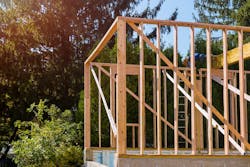Softwood Lumber Prices Fall Dramatically in November
Prices paid for goods used in residential construction ex-energy dropped slightly in November but retained high year-to-date rates. Index for inputs to residential construction, which included food and energy, also decreased. Both decreased by less than 1% while the core index for building materials remained 3.9% higher compared to last year. The largest drop could be found in the prices paid for softwood lumber, which saw a 17.8% decline in November after a 7.4% decrease in October. Still, softwood lumber prices are 45.4% higher than April.
Although, according to Random Lengths data, lumber prices began climbing again in mid-November, the timing of the PPI survey makes it likely that the majority of upward price movement will not be evident in the BLS data until the next release in January 2021.
Not only has softwood lumber reached historic highs in terms of prices this year, but those prices have been extremely volatile. The two most volatile years for the softwood lumber PPI since 2001 have been 2020 (0.45) and 2018 (0.29). In contrast, the 20-year annualized volatility has been roughly 0.14. This year’s price index has been roughly four times as volatile as it was during the recessionary years of 2008 and 2009.
